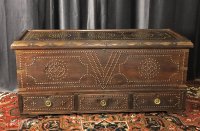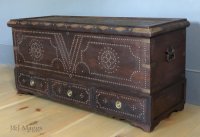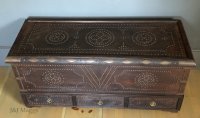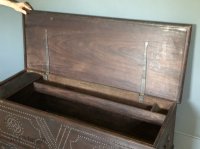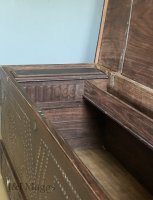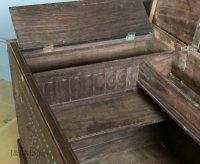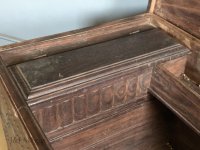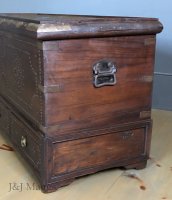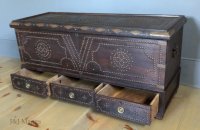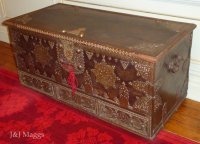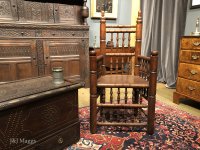Jan & John Maggs Antiques and Art
An early Moorish oak chest decorated with brass studs [27148]
Circa: 1750
$495
Item Details
Realizing that it was an early piece, we purchased this chest locally and set it aside to begin our research early in 2024. By a huge and helpful coincidence, during our Fall visit to the Palace of Holyrood in Edinburgh, we happened upon several similar chests in the Great Gallery. Here is a transcription of the description of one of these chests:
Chest 1700 – 50. Oak, copper, RCIN 6878
An oak chest, studded and mounted with pierced copper plaques, corner mounts and strapwork hinges, the copper tooled with foliate patterns. The chest has three drawers at bottom, each with studded borders and D-shaped handles. (NOTE: The image containing the red carpet is of the chest found in Holyrood.)
While the two chests are not identical, they have enough in common to identify ours. We should note that the bottom of the till slides out to open a large hidden compartment extending to the bottom of the chest.
Moorish, ca. 1750
Dimensions: 45” X 17”; Height: 21 ¼”
Like to see more? CLICK HERE to visit our website.
Jan & John Maggs Antiques and Art
[email protected] Maggs
2 Old Cricket Hill Road
Conway, MA, 01341
United States
Phone: 4133694256
Visit Website
.jpg)
More Information
Booth 11
Shipping and Returns
Shipping: We offer free shipping through USPS for most smaller pieces, as noted in the item descriptions, and we will pack and arrange for the delivery of most others. For this latter group, we won’t charge for packing but will expect the buyer to pay the actual cost of shipping and insurance. For other pieces, we're happy to obtain quotes from reliable couriers and shippers. Please contact us with your address and ZIP code.Payment: We prefer payment by credit card or Zelle as well as by check from known buyers. PayPal Is an acceptable alternative. Payment by check usually will delay shipping until after payment is received.
Returns: We will refund the full amount of the purchase price if the article is not as described. These conditions will apply:
1. Returns must be requested within 24 hours of receipt of the piece.
2. The piece must not be “shopped around”, including the forwarding of photographs to prospective buyers.
3. Once we have approved a return, the refund will be made after the piece reaches us in the condition in which it was sent.
4. Buyers are responsible for return shipping costs.
Additional Information
When Jan, a collector of antique jewelry and period furniture, and John, a teacher and musicologist, met in the early 1980’s, it was no accident that their shared interests in music, art, and antiquities would morph into a rewarding enterprise. Jan’s family had been in the jewelry business since the 1800’s, and her passion for early jewels and period English furniture are grounded in this background. John’s career had been in the fields of teaching, conducting, and musicology, with an emphasis on the 16th and 17th centuries.When first together, they spent weekends buying at tag sales and Sunday flea markets. But soon they began to sell at these same markets as well as in two local multi-dealer shops. In 1985, as the fledgling business began to grow, they purchased a derelict 18th-century farmhouse and outbuildings in Conway, Massachusetts. Thus began a decades-long restoration project.
Even as the restoration demanded hours of exhausting labor, in addition to their day jobs, they began to exhibit at some of the myriad antiques shows throughout New England and New York, in one remarkably active year, exhibiting at 43 shows.
While initially focusing on American furniture and smalls, interests soon turned to the era with which they now live, early English oak. Following the leads of a few dealer friends, they made their first trip to England together in 1993, finding pieces they loved at prices that allowed them to bring them home and make them available at reasonable prices. Thus began a pattern of semi-annual buying trips to England, traveling in the spring and in the fall, with a gala opening in our shop soon after their return.
In February of 2017 the barn which they had passionately restored and turned into the home of their business was flattened by a freak tornado. Thanks to insurance companies that honored their obligations, they were able to design and build a new barn with comfortable and spacious showrooms in which early oak furniture, early jewelry, and paintings and accessories from the past four centuries can be displayed in room settings. John and Jan are eager to show off the new space and ever-evolving inventory, and they open the doors of the barn regularly to visitors who call for an appointment or who drop in by chance. If you visit our website, you'll find a link there to a recent video of the shop, so you can visit virtually in Conway, too. You'll also find a link on the home page through which you may easily sign up for our informative monthly e-newsletters.
![An early Moorish oak chest decorated with brass studs [27148]](https://nyantiques.us-east-1.linodeobjects.com/thumbs/1735938448271480.jpg)
